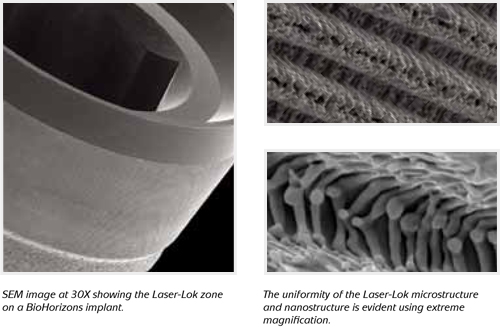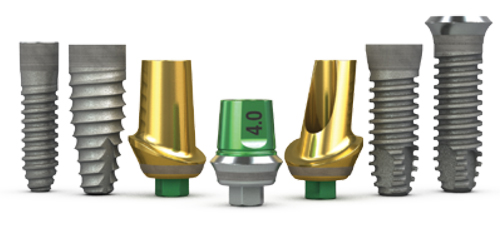- info@dentalant.net
- +381 (0) 11 3286 256
- +381 (0) 11 2620 546
Laser-Lok Technology
Laser-Lok overview

Laser-Lok microchannels is a proprietary dental implant surface treatment developed from over 20 years of research initiated to create the optimal implant surface. Through this research, the unique Laser-Lok surface has been shown to elicit a biologic response that includes the inhibition of epithelial downgrowth and the attachment of connective tissue (unlike Sharpey fibers). This physical attachment produces a biologic seal around the implant that protects and maintains crestal bone health. The Laser-Lok phenomenon has been shown in post-market studies to be more effective than other implant designs in reducing bone loss.
Unique surface characteristics
Laser-Lok microchannels is a series of cell-sized circumferential channels that are precisely created using laser ablation technology. This technology produces extremely consistent microchannels that are optimally sized to attach and organize both osteoblasts and fibroblasts.8,9 The Laser-Lok microstructure also includes a repeating nanostructure that maximizes surface area and enables cell pseudopodia and collagen microfibrils to interdigitate with the Laser-Lok surface.

Different than other surface treatments
Virtually all dental implant surfaces on the market are grit-blasted and/or acid-etched. These manufacturing methods create random surfaces that vary from point to point on the implant and alter cell reaction depending on where each cell comes in contact with the surface.10 While random surfaces have shown higher osseointegration than machined surfaces,11 only the Laser-Lok surface has been shown using light microscopy, polarized light microscopy and scanning electron microscopy to also be effective for soft tissue attachment.
The clinical advantage

The Laser-Lok surface has been shown in several studies to offer a clinical advantage over other implant designs. In a prospective, controlled multi-center study, Laser-Lok implants, when placed alongside identical implants with a traditional surface, were shown at 37 months post-op to reduce bone loss by 70% (or 1.35mm). In a retrospective, private practice study, Laser-Lok implants placed in a variety of site conditions and followed up to 3 years minimized bone loss to 0.46mm. In a prospective, University-based overdenture study, Laser-Lok implants reduced bone loss by 63% versus NobelReplace™ Select.
Latest discoveries

The establishment of a physical, connective tissue attachment (unlike Sharpey fibers) to the Laser-Lok surface has generated an entirely new area of research and development: Laser-Lok applied to abutments. This could provide an opportunity to use Laser-Lok abutments to create a biologic seal and Laser-Lok implants to establish superior osseointegration9 – a solution that offers the best of both worlds. Alternatively, Laser-Lok abutments could support peri-implant health around implants without Laser-Lok. In a recent study, Laser-Lok abutments and standard abutments were randomly placed on implants with a grit-blasted surface to evaluate the differences. In this proof-of-principle study, a small band of Laser-Lok microchannels was shown to inhibit epithelial downgrowth and establish a connective tissue attachment (unlike Sharpey fibers) similar to Laser-Lok implants.12 This time, however, the attachment was established above the dental implant-abutment connection and even on implants with a machined collar.12 The resulting crestal bone levels were higher than what was seen with standard abutments and provides some insight into the role soft tissue stability may play in maintaining crestal bone health.


 Brochure
Brochure